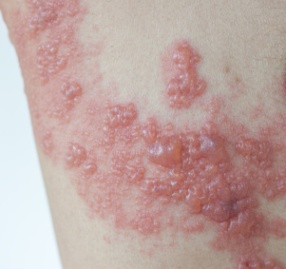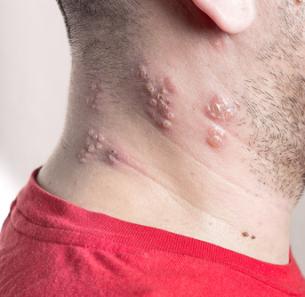
As you age, it’s important to understand and be aware of the symptoms of the shingles virus, which is the inflammation of nerves beneath the skin caused by the same virus as chickenpox, varicella-zoster. As you may know, if you’ve been infected by chickenpox, no matter what age, you are at risk to also develop shingles, as the varicella-zoster virus can lie dormant in your nervous system for decades.
Shingles occur when the virus reactivates for reasons not fully understood, and moves through nerve pathways to the skin. Outward signs of shingles typically include patches of blisters along one side of the body, which make the virus easy to identify.
Signs and Symptoms of Shingles Virus
The most clearly defining symptom of shingles is pain, which in some cases can be excruciating. Pain associated with shingles, though it is often the first of many symptoms, can sometimes be mistaken for other severe maladies involving other organs and can also manifest as burning, tingling, or even numbness. The external signs of shingles that are plainly visible to the naked eye are considered further evidence and confirmation of the disease. They typically include a bright red rash accompanied by blisters that are filled with fluid and crust over upon breaking. The shingles rash is often distinct, forming a stripe or patch of blisters that envelops one side of the torso. A shingles rash can also manifest around the eye, neck, or face, again, typically on only one side. Additional signs and symptoms of shingles virus can include itching, headache, sensitivity to sunlight, fatigue, high fever as the body fights the virus, and sensitivity to touch.
It’s worth noting that, while people affected by shingles may experience intense symptoms such as pain, they may never develop some of the outward signs of the virus, like an external rash. This can make shingles harder to identify. We recommend seeking immediate medical attention if you experience any of the signs or symptoms associated with shingles for a proper diagnosis, particularly if any of these occur around the eye area, as this can lead to severe complications and potential loss of vision.
Complications Related to Shingles
While shingles are not life-threatening if the virus is not identified and tended to properly, there is a high potential for complications to occur. These may include:
- Skin infections, which can occur when broken shingles sores are not cared for properly.
- Vision loss due to shingles in and or around the eye, which can cause additional infection and permanent impairment.
- Neurological damage can result from shingles, which may include inflammation in the brain, hearing and balance issues, and in some cases facial paralysis.
- Post-herpetic neuralgia, which happens when nerve fibers are damaged from shingles after sores have healed and sent inaccurate and exaggerated pain signals from the skin to the brain.

Is Shingles Contagious?
Yes. The varicella-zoster virus can spread to anyone not immune to chickenpox through direct contact with open shingles sores. Once infected, the recipient will develop chickenpox, not shingles. In addition to those who are not immune to chickenpox, it’s important to acknowledge that shingles can be particularly harmful to certain groups of people, and you should avoid contact with the following:
- Infants and newborns.
- People who have weak immune systems.
- Women who are pregnant.
Who is at Risk?
It is unclear why the varicella-zoster virus can lay dormant and reactivate as shingles. While many believe decreased immunity with age plays a part, it’s important to reiterate that anyone who has endured chickenpox is susceptible to developing shingles. Certain factors, however, affect likelihood, including:
- People ages 50 and older are at an increased risk of developing shingles.
- People enduring oncology treatments like radiation and chemotherapy may have lower immunity and resistance, which can allow the shingles virus to reactivate.
- Specific diseases that impact the immune system, like HIV/AIDS, can decrease the body’s ability to fight diseases like shingles.
What Can You Do to Treat Shingles?
While there is no cure for shingles, there are remedies that can help speed the healing process, relieve the symptoms of the shingles virus, and minimize the potential for complications. Of course, if you are unsure of your best course of treatment, we recommend consulting with your physician. We suggest Naturasil, a natural homeopathic formula made of plant extracts and without harsh chemicals. Naturasil works to reduce or eliminate the symptoms associated with shingles and to aid your body in fighting against potential repeat outbreaks. Just follow the links to the Naturasil website to learn more.
